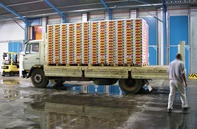The Ability to Move Food
When human societies first made the switch from a roaming, hunting-gathering existence to that of formal agriculture about 10 000 to 12 000 years ago, it was the ability to produce and store surplus food that then freed up people to become something other than producers of food.

Instead of working the land, people could become specialists in other fields: carpenters, bricklayers, ironmongers and seamstresses; writers, politicians, actors and physicians; road builders, engineers, painters and plumbers. And they did not need to live on the land or spend hours hoeing, weeding, harvesting or fighting pests.
And so they came together in settlements that were trickle-fed by the continuing productivity of those who stayed behind on the farm and turned the fruit of their land into a business. But precisely where these non-agrarian communities could gather in towns and villages and, later, cities was still defined by the distances which that food had to travel.
Before industrialisation, it was how far an oxcart, carriage or person could walk before the food went off. Cities formed around geographical hubs that reflected the ability of that society to move food about with whatever technology was available at the time. And the speed and efficiency of those feeder arteries determined how big or fast cities developed.
Advent of the Railway
Hungry City author Carolyn Steel writes about how London in the mid-1800s was limited to a size of about 2.5 million people as long as food was traipsing into the city along roads, under animal power.
Meat was walked into the city on the hoof, sometimes from great distances, before being slaughtered and sold from the meat market in today’s Smithfield; turkeys and geese were also herded in from afar, often with specially made protective cloth on their feet; tea, grains and sugar came up the Thames in clippers; milk came from often-grubby cow sheds operating within the confines of the city; fresh fruit and vegetables came from nearer the city.
Food could only move as fast as the cows’ feet could travel or the inbound wind could carry ships up the river, so the population of the city could not swell beyond what this relatively sluggish system allowed. It was the advent of the railway that changed all of that for the pre-industrial city, writes Steel. Suddenly food was rocketing into the urban heartland under steam power (milk, for instance, could leave Devon about 250 or so kilometres away at six in the morning and arrive in the city in time for breakfast).
More calorific oxygen to the city meant it could grow, and grow it did! Fossil fuels, train lines and internal combustion engines freed up cities from the geography that previously locked them into certain locations, such as being close to river mouths or harbours, or the networks of interlinked navigable canals, or close to productive farmland.
Rail and, later, roads extended the reach of food-flow systems and sped it up dramatically, allowing new cities to germinate in places where previously the geography had been too infertile.
Changing the Nature of Food
The industrialisation of both our food systems and shipping meant that we could roll a greater surplus off the food-production line, and deliver it further than ever, faster than ever. The distance between farm and fork could be half the globe away since now even the most delicate fruits can be flown to lucrative markets in the belly of an aeroplane.
And technological advances also mean presently that even some of the most perishable fruits – soft fruits like pears, for instance – could be harvested this summer and kept in a kind of gaseous suspension (‘controlled atmosphere storage’, where the fruit is held at a low temperature in a high carbon dioxide environment to reduce spoilage dramatically) until the following year, before they get lifted off the retailer’s shelf by the consumer, still crisp as ever.
And yet this very need to keep food from spoiling before it reaches its market has changed the nature of the food available to us in the city these days, some of the health implications of which we are only just beginning to see popping up in general practitioners’ practices, emergency rooms and dieticians’ consulting rooms in the past three or four decades.
This is one key factor in what is being dubbed the ‘nutritional transition’ – how much our eating patterns change when we are urbanised – and why there are growing concerns about how the modern food system is allowing us to eat ourselves into an early grave.
By Leonie Joubert